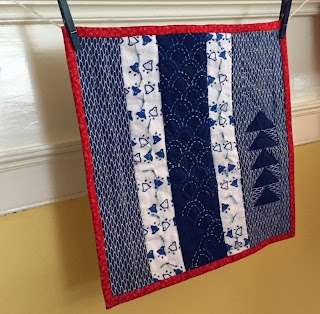I decided to enter the challenge just last week, and so I was working against the clock but still wanted to create something homespun and handmade.
Naturally the sea birds needed some sashiko waves...
Settled on larger geese against a fishnet tenugui background.
Meanwhile....
Here's Daisy promising not to eat our cabinetry. She's just over a year old now and we are catching glimpses of the great dog she will become. ;). For the past couple weeks I've been saying "I think we've turned the corner with Daisy." But she's still not allowed in the kitchen unattended!
* What is tenugui anyway? I wrote more about it in my previous blogspot (A Quilter By Night) but here in a nutshell:
tenugui - a Japanese woven, hand-dyed cotton towel. They are traditionally used by people who work with their hands - carpenters, chefs, gardeners, etc. Long and narrow, they can be worn as headbands or neck scarves, or used as hand towels.






What a sweet little quilt. And thank you for the tenugui explanation as I would have had to look it up! Congratulations Daisy for learning to be a grown up dog. Don't lose your puppy spirit, just your teething rituals!
ReplyDeleteThank you Wendy! Tenugui is wonderful to use in quilting - it is 100% cotton, very durable, but the weave is loose. I collected quite a few while we lived in Japan!
DeleteWhat an interesting piece! I love its colors. And the sashiko is beautifully done. Neat stitches!
ReplyDeleteThank you for the compliment, France!
DeleteTenugui are also a choice to promote a show or maybe a concert or performance by a dancer or Kabuki artist and the like. The strips of cloth are quite narrow, 15 inches or so, and when they are dyed, the dye is passed through a pile of fabric, dying all the way through, making reverse side just the same as the front. It could be a problem when using with printed words because some would be reversed.
ReplyDeleteGreat info to add, Julie! Thank you! You are the queen of tenugui! Miss you!
DeleteLovely Cynthia! I'm enjoying seeing your sashiko and your growing dog. They are a joy when you can begin to trust them a little more. Ours is also turning into a delight!
ReplyDeleteThank you Camilla! Yes... I had many moments of near-despair with her, but not anymore! Now it's just the constant shedding....
Delete